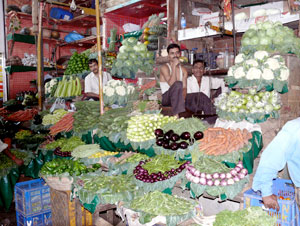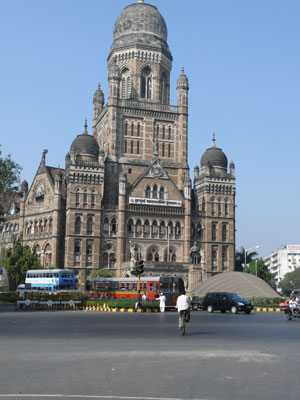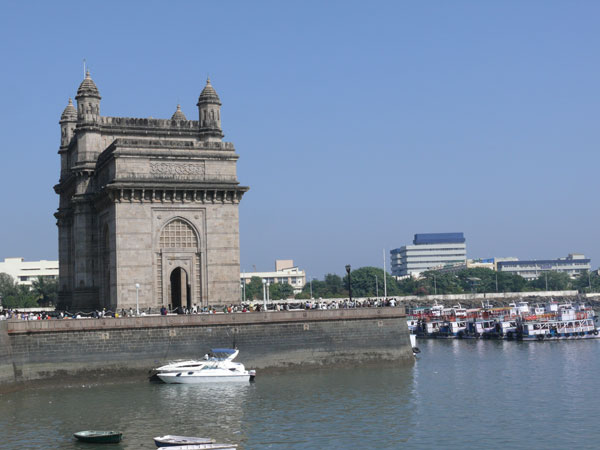MUMBAI - It’s just a few minutes before noon but already the landmark Leopold Café and Bar is crowded and the Kingfisher beer is being served by the “yard” in unique tumblers that are marked like rulers – a Leopold tradition we are told.
Most of the patrons are foreigners – the famed Leopold, opened in 1871, is where writers like Rudyard Kipling hung out when they visited this city once known as Bombay - and still called that by most locals.
The bar is where we agreed to meet our city guide, a scholarly man named Douglas Cyrus, who we’ve hired to show us this vibrant city of 18 million people – the largest and most cosmopolitan in India.
A late arrival the night before did not permit us seeing much of Mumbai so far. A walk from the famed Taj Mahal Palace Hotel along the street where the Leopold is located, has introduced us to sidewalk vendors who politely push local crafts and knockoff merchandise at us; and some beggars. We expected to see much worse.
Most of the stories we’d read preparing for this trip warned of the social horrors we would witness on the streets of Mumbai – one of the poorest cities in the world.
“Excuse me, I am Douglas Cyrus. You are …”
We jump to our feet, welcome our guide and invite the slight man to join us for a drink.
“We only have time for an inch of beer – maybe two. We can’t order a yard – we have too much to see today,” said Cyrus, who has been guiding people around Mumbai for more than a dozen years now.
We tell Cyrus of our first impressions and he laughs at our pre-conceived fears.
The city’s grand buildings are holdovers from its colonial past. “Seeing poverty in any Indian city is not difficult,” he tells us. “But Bombay has many beautiful things to see as well. So let’s drink up and be on our way.”
Cyrus tells us that Bombay really is a good place – “the word “bom” means good and the city sits on the shores of the Bay of Bengal – hence the name, Bombay, which is the name the British called the city when they occupied the country.
Mumbai is spread out over 440 square kilometers, Cyrus tells us as we crawl through some slow-moving Saturday morning traffic on our way to Crawford Market, the bustling gathering spot where hundreds of thousands converge each day to buy spices, produce, meat and other wares.
The traffic was very slow so Cyrus had plenty of time to fill us in on the city’s history.
“Bombay was at first a collection of seven islands which the British joined together after the Portuguese left in the 17th century after making the islands a gift to the British king,” he told us as we passed trough a section of the city known as the fort area.
We made our way past the Flora Fountain, the centre of the city and the place many people call Bombay’s Piccadilly after the London landmark, and turned onto a tree-lined boulevard with a collection of handsome buildings clustered together. Cyrus identified them as belonging to Bombay University, a sprawling institution that is home to over three million students. The university’s buildings, designed in Gothic, Muslim and Hindu styles of architecture, were some of the most beautiful we’d seen on a week-long tour of India. One building that stood out above all others, though, was the Prince of Wales Museum.



Left: Bustling Crawford Market is full of rich spices and smells. Middle: The city’s grand buildings are holdovers from its colonial past. Right: India Gate welcomes visitors to Mumbai, formerly Bombay.
Back in the car, the driver jostled with taxis and ox-pulled carts and a few stray cows – “the city is rounding up the cows these days so the streets won’t be so congested,” Cyrus told us – before pulling up in front city hall, another impressive structure left over from the British reign that sits directly across from Victoria Terminus, possibly the busiest train station in the world where over three million commuters pass through each day.
The one thing you quickly realize about Bombay is that it is much greener than other Indian cities – boulevards have that European look thanks to the trees that canopy them and protect pedestrians and motorists from the oppressive heat that descends on this city during the hottest months.
“There are 29 parks in Bombay with the Hanging Gardens the most beautiful,” said Cyrus who promised we would visit the gardens that overlook the Bay of Bengal a little later.
The driver has diverted from the main road and we find ourselves up a back ally where he parks at the rear of a large complex Cyrus told us was Crawford Market.
The air around the market was punctuated with scents – the aroma of spices filled our nostrils and quickened our pace to get to the stalls where men politely pushed rich-coloured curry at us.
“Please sir, buy my curry spice – the finest in India,” one vendor assured us.
Others were quick to challenge the man and soon others were making the same promise.
The market was thick with people and produce and anything else you wanted to buy, including lots of Christmas decorations, which surprised us during our mid-December visit.
“The vendors see the commercial value in Christmas and all other holidays, no matter the religion,” laughed Cyrus. Loaded with some saffron – the spice worth its weight in gold back home (literally) and purchased for just a few dollars in the market – and a variety of other goodies, we pressed on with our tour.
The driver headed down what Cyrus described as Marine Drive, a lovely stretch of asphalt lined on one side with parks where cricketers were playing their favourite sport and a collection of modern buildings – home to Mumbai’s newest hotels and businesses – and on the other by a beautiful shoreline where the Arabian Sea comes ashore.
A number of billboards lining the street advertised the city’s fastest growing industry, cosmetic surgery.
“Many people now come to India to have cosmetic procedures as well as many other surgeries,” said Cyrus. “We have great doctors in India and procedures, including many heart operations, are much cheaper in Bombay. We have many Americans coming here for such surgeries – they make it part of their holidays now.”
The light of day was dimming when our driver turned into a residential area known as Laburnum Road and stopped in front of a cottage-like home at Number 19.
“I could not allow you to leave Bombay without showing you one of our most important landmarks,” said Cyrus as we looked at the non-descript home with the simple features.
“This is Mani Bhavan – the home where Mahatma Gandhi lived when he was in Bombay,” said Cyrus. “Gandhi took his first lessons in carding here and learned how to weave in this house.
“It was also here that Gandhi defied the British and issued his weekly Satyagrahl newspaper that helped ignite India’s thirst for independence,” said the guide.
This is the home where the revered Gandhi also started his historic fast in 1921 in an effort to restore peace to the city at the time of the boycott of the visit of the Prince of Wales that same year.
Today, Mani Bhavan is used as a research institute by Mumbai University and its library consists of over 50,000 reference books. The top floor of the building has been turned into an auditorium where films about Gandhi’s amazing life are shown and meetings are held.
The bedroom and its simple furnishings used by Gandhi during his stay in Bombay have been preserved and the room next to it offers an exhibition depicting Gandhi’s life through miniature figures. There’s also a picture gallery that offers glimpses of Gandhi’s incredible life at the house.
Cyrus and the driver deposited us at our hotel, which sits in the shadow of the impressive Gates of India (check name), a little while later and as he departed he turned and said: “Don’t believe all you read about Bombay.”